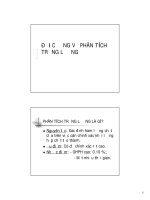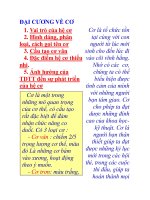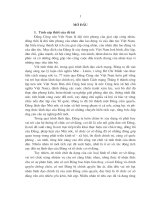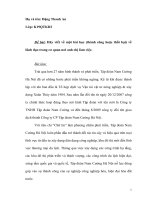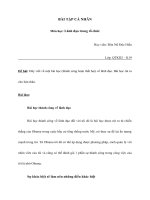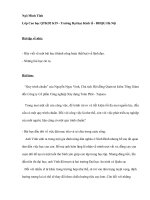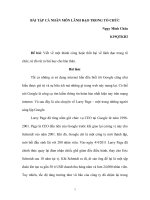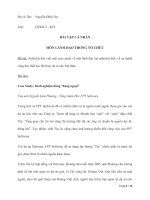Đại cương về lãnh đạo trong tổ chức chapter 1 who is a leader
Bạn đang xem bản rút gọn của tài liệu. Xem và tải ngay bản đầy đủ của tài liệu tại đây (471.08 KB, 44 trang )
LEADERSHIP:
.c
om
Theory, Application, Skill Development
an
co
ng
4th Edition
du
o
ng
th
Robert N. Lussier
and Christopher F. Achua
.
cu
u
This presentation updated and enhanced by:
Rhonda S. Palladi, Ph.D.
Georgia State University
J. Mack Robinson College of Business
Managerial Sciences Department
Atlanta, GA 30302
Copyright (c) 2010 by South-Western/Cengage Learning. All rights reserved.
CuuDuongThanCong.com
/>
.c
om
ng
th
an
co
ng
Chapter 1
cu
u
du
o
Who Is a Leader?
Copyright © 2010 by South-Western/Cengage Learning
All rights reserved.
CuuDuongThanCong.com
PowerPoint Presentation by Rhonda S. Palladi
Georgia State University
/>
.c
om
Chapter 1
Learning Outcomes
cu
u
du
o
ng
th
an
co
ng
Briefly describe the five key elements of leadership.
List the ten managerial roles based on their three
categories.
Explain the interrelationships among the levels of
leadership analysis.
Describe the major similarity and difference between the
trait and behavioral leadership theories.
Discuss the interrelationships between trait and behavioral
leadership theories and contingency theories.
Define the key terms listed at the end of the chapter.
3
CuuDuongThanCong.com
/>
.c
om
Why Leadership is Important
cu
u
du
o
ng
th
an
co
ng
For individual career success and organizational
performance: the success of individual careers
and the fate of organizations are determined by
the effectiveness of leaders’ behavior.
For employee recruitment and retention: the
organization’s leaders must foster a leadership
mentality throughout the organization.
The past few years well-publicized corporate
failures have pointed to the critical role that
leadership plays in the success or failure of
organizations.
4
CuuDuongThanCong.com
/>
.c
om
Defining Leadership
cu
u
du
o
ng
th
an
co
ng
No universal definition
Leadership is complex and thus hard to
define
Many different definitions
5
CuuDuongThanCong.com
/>
.c
om
Defining Leadership (cont.)
cu
u
du
o
ng
th
an
co
ng
Leadership is the influencing process of
leaders and followers to achieve
organizational objectives through change
6
CuuDuongThanCong.com
/>
th
an
co
ng
Influence
.c
om
Key Elements of Leadership
Leaders–
Followers
Organizational
Objectives
cu
u
du
o
ng
Leadership
Change
People
7
CuuDuongThanCong.com
/>
ng
.c
om
Discussion Question #1
cu
u
du
o
ng
th
an
co
Should leadership be the
manager’s job, or should
leadership be a shared process?
8
CuuDuongThanCong.com
/>
ng
.c
om
Discussion Question #2
cu
u
du
o
ng
th
an
co
Are you interested in sharing
leadership, or do you prefer to be
a follower?
9
CuuDuongThanCong.com
/>
.c
om
Functions Performed by Managers
ng
th
an
co
ng
All managers perform four major
functions:
Planning
Organizing
Leading
u
du
o
Thus, leadership is a part of every manager’s
job
cu
Controlling
10
CuuDuongThanCong.com
/>
.c
om
Are All Leaders Managers?
cu
u
du
o
ng
th
an
co
ng
Manager = formal title and authority
Leader = person (manager or
nonmanager) with influence
Follower = person influenced by a leader
11
CuuDuongThanCong.com
/>
.c
om
Influence
cu
u
du
o
ng
th
an
co
ng
Is the process of a leader communicating
ideas, gaining acceptance of them, and
motivating followers to support and
implement the ideas through change
It is the essence of leadership
Managers may influence through coercion
Leaders influence by gaining followers’
commitment and enthusiasm
12
CuuDuongThanCong.com
/>
.c
om
Effective Leaders
cu
u
du
o
ng
th
an
co
ng
Know when to lead and when to follow
Influence followers to support
organizational interests
Provide direction
Set challenging objectives and lead the
charge to achieve them
Influence change for continual
improvement
Enjoy working with people
13
CuuDuongThanCong.com
/>
co
ng
.c
om
Discussion Question #3
cu
u
du
o
ng
th
an
Are leaders born or made?
14
CuuDuongThanCong.com
/>
.c
om
Are Leaders Born or Made?
cu
u
du
o
ng
th
an
co
ng
Most researchers say the answer is both
Some are born with natural ability and
develop it
Some are developed through effort and
hard work
All people have potential leadership skills
Organizations spend millions of dollars
every year to develop leadership skills of
their employees
15
CuuDuongThanCong.com
/>
.c
om
Leadership Managerial Roles
1. Figurehead
2. Leader
3. Liaison
an
co
ng
Interpersonal
u
du
o
ng
th
Informational
cu
Decisional
4. Monitor
5. Disseminator
6. Spokesperson
7. Entrepreneur
8. Disturbance-handler
9. Resource-allocator
10. Negotiator
16
CuuDuongThanCong.com
/>
.c
om
Interpersonal: Figurehead Role
u
du
o
Signing official documents
Entertaining clients and official visitors
Speaking engagements (formal and informal)
Presiding at meetings and ceremonies
cu
ng
th
an
co
ng
Represent the organization or department in
legal, social, ceremonial, or symbolic activities
Generally considered a top management function
However, leaders throughout the organization
can perform this role
Includes:
17
CuuDuongThanCong.com
/>
.c
om
Interpersonal: Leader Role
th
an
co
ng
Pervades all managerial behavior
Influences how leaders perform other
roles
Includes:
cu
u
du
o
ng
Hiring and training
Giving instructions and coaching
Evaluating performance
18
CuuDuongThanCong.com
/>
.c
om
Interpersonal: Liaison Role
co
ng
Interacting with people outside the
organizational unit
Includes:
u
du
o
ng
th
an
Networking
Developing relationships
Gaining information and favors
Serving on committees
Attending professional meetings
Keeping in touch with other people and
organizations
cu
19
CuuDuongThanCong.com
/>
.c
om
Informational: Monitor Role
u
du
o
ng
Reading memos, reports, and publications
Talking to others
Attending meetings
Observing competitors
cu
th
an
co
ng
Gathers information
Analyzes the information to discover
problems and opportunities
Includes:
20
CuuDuongThanCong.com
/>
.c
om
Informational: Disseminator Role
ng
Sends information to others
Information passed via:
co
Oral means
ng
th
an
– Telephone or voice mail
– One-on-one discussions
– Meetings
du
o
Written media
cu
u
– Printed documents
– Handwritten notes
21
CuuDuongThanCong.com
/>
.c
om
Informational: Spokesperson Role
co
ng
Provides information to people outside
the organizational unit
Examples:
cu
u
du
o
ng
th
an
Meeting with the boss to discuss performance
Meeting with the budget officer to discuss the
unit budget
Answering letters
Reporting information to the government
22
CuuDuongThanCong.com
/>
.c
om
Decisional: Entrepreneur Role
an
co
ng
Innovative
Initiation of improvements
Examples:
cu
u
du
o
ng
th
Developing new or improved products and
services
Developing new ways to process products
and services
Purchasing new equipment
23
CuuDuongThanCong.com
/>
.c
om
Decisional: Disturbance-Handler Role
u
du
o
A union strike
Equipment breakdown
Needed material not arriving on time
Tight schedules
cu
ng
th
an
co
ng
Takes corrective action during crisis or
conflict situations
Involves reactions to unexpected events
Leaders typically give this role priority
Examples:
24
CuuDuongThanCong.com
/>
.c
om
Decisional: Resource-Allocator Role
th
an
co
ng
Involves scheduling, requesting
authorization, and performing budgeting
activities
Examples:
cu
u
du
o
ng
Deciding what is done now, later, or not at
all
Setting priorities and time management
Allocating raises, overtime, and bonuses
Scheduling employee, equipment, and
material use
25
CuuDuongThanCong.com
/>
